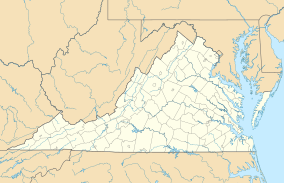| Johnsons Creek Natural Area Preserve | |
|---|---|
| Location | Alleghany County, Virginia |
| Coordinates | 37°50′04″N 80°04′51″W / 37.8344°N 80.0809°W[1] |
| Area | 99 acres (40 ha) |
| Established | 1990 |
| Governing body | Virginia Department of Conservation and Recreation |
Johnsons Creek Natural Area Preserve is a 99-acre (40 ha) Natural Area Preserve located in Alleghany County, Virginia. It contains a variety of trees, including ancient red cedars, oaks, and pines, all of which stand on steep shale bluffs overlooking Johnsons Creek.[2]
The preserve protects a type of natural community known as a "shale barrens". Shale barrens are typified by thin soils on south-facing slopes, and feature hot, dry conditions. They are rare in the eastern United States; within Virginia, this type of landscape is restricted largely to the Ridge and Valley region.[3] Several rare plants are found at Johnsons Creek Natural Area Preserve, including the shale-barren rockcress (Boechera serotina).[2]
Johnsons Creek Natural Area Preserve was initially purchased by The Nature Conservancy, and was dedicated as a Natural Area Preserve in 1990.[3] The preserve is owned and maintained by the Virginia Department of Conservation and Recreation. It does not include improvements for public access, and visitors must make arrangements with a state-employed land steward prior to visiting.[2]
See also
[edit]References
[edit]- ^ "Johnsons Creek Natural Area Preserve". The Conservation Tax Center. Resources First Foundation. Retrieved December 20, 2016.
- ^ a b c "Johnsons Creek Natural Area Preserve". Virginia Department of Conservation and Recreation. Retrieved December 20, 2016.
- ^ a b Winegar, Deane; Winegar, Garvey (2002). Highroad Guide to the Virginia Mountains. John F. Blair. pp. 150–151. ISBN 9780895872777.
External links
[edit]

Well, that’s interesting to know that Psilotum nudum are known as whisk ferns. Psilotum nudum is the commoner species of the two. While the P. flaccidum is a rare species and is found in the tropical islands. Both the species are usually epiphytic in habit and grow upon tree ferns. These species may also be terrestrial and grow in humus or in the crevices of the rocks.
View the detailed Guide of Psilotum nudum: Detailed Study Of Psilotum Nudum (Whisk Fern), Classification, Anatomy, Reproduction